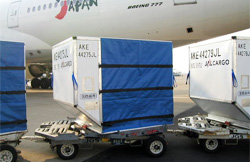Aircraft use fossil fuels (jet fuel and aviation gasoline) to fly, which emits CO2 (carbon dioxide), a cause of global warming. We have implemented a variety of measures to reduce CO2 emissions, even by a little.
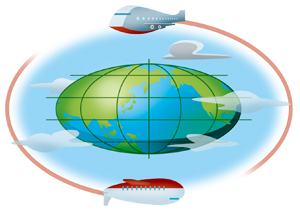
- How much fuel does an aircraft use when it flies?
As an example, to fly a Boeing 777-200 from Haneda to Sapporo, it takes about 19,700 liters of fuel. This is the equivalent of about 100 drums of fuel, or about 330 cars with their tanks full of fuel. Incidentally, in terms of CO2 emissions from industry and our everyday lives in Japan, the transportation sector, including private cars, cargo vehicles and buses accounts for about 20% of emissions. Air transportation accounts for about 4% of this, or about 0.8% of total emissions in Japan.
Pilots require a lot of training in order to fly an aircraft. In the past, training was conducted using actual aircraft, but since this used a lot of fuel, we currently use simulators for most of our training. As a result, we have been able to significantly reduce the amount of fuel used in training, and the resulting burden on the environment.
- Are there any aircraft with low CO2 emissions?
There are no aircrafts that are free of CO2, but advances in technology have dramatically improved fuel efficiency in recent decades. For example, the new Boeing 777 emits as much as 37% less CO2 than the older 747. At the JAL Group, we are increasing new Boeing 777, 787 and 737-800 aircraft which have better fuel efficiency and less CO2 emissions.
It is also possible to reduce CO2 emissions even with the same aircraft and the same engine, depending on how it is maintained. As the engines are used, small pieces of dust or dirt stick to the blades of the air compressor. This reduces the air compression ratio, which in turn reduces fuel efficiency. Therefore, the JAL Group ensures that the inside of the engine is cleaned regularly, so that engine efficiency can be recovered. Every 6 months, 70% of the aircraft owned by the JAL Group are cleaned, leading to a reduction of more than 50,000 tons of CO2 emissions every year. Also, water drainage is collected after cleaning and then processed using specially developed equipment in order to prevent increased burdens on the environment.
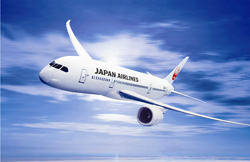
Boeing 787
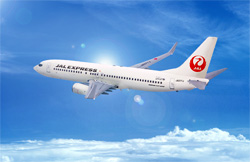
Boeing 737-800
- How do you fly in a way to reduce wasted fuel?
-
Flying an aircraft is the repetition of increasing height after take-off, maintaining a certain height (cruising) and then reducing height for landing. We promote "Eco-Flight Activities" at every stage of take-off, climbing, cruising, descent and landing, to reduce fuel consumption. For example, when strong head winds are encountered during cruising, fuel can be saved by changing altitude. Also, due to changes in weather and airflow, and directions from control towers etc., aircrafts usually do not fly in a straight course to their destination. Among these various constraints, we try to pick the best route to conserve fuel.
In addition to selecting the optimal altitude, route and speed in this way, we are committed to operations that have a low impact on the environment, to the extent that this does not impair safety, through such measures as operating equipment at optimal timing, reducing the use of reverse thrust when landing, and stopping the engines on one side when taxiing. Also, the JAL Group has actively adopted new environmentally friendly operating systems are ahead of our competitors, such as tailored arrival.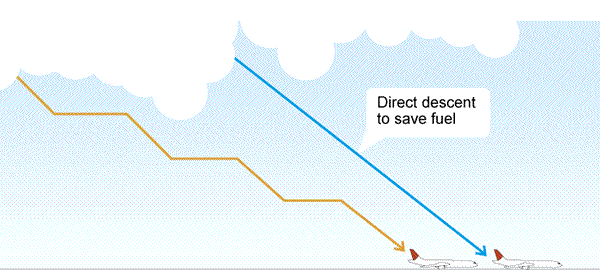
- Do aircraft emit CO2 when they are completely stopped?
-
Aircraft are equipped with an APU auxiliary power unit which provides electricity and air conditioning inside the cabin even when the engine is turned off at the airport. However, since this also requires aviation fuel, it emits CO2. At the same time, when the aircraft is on the tarmac, it can be supplied with electricity through the GPU ground power unit, which can significantly reduce exhaust gas and noise. We try to reduce the use of APU, and use GPU as much as possible.
Also, within the JAL Group, from spring to autumn, we reduce the cooling time using the APU based on the climate of the foreign destination to reduce CO2 emissions, and with the cooperation of our passengers we implement measures such as keeping the window awnings lowered.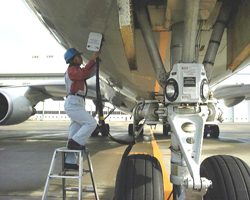
- What do you do to keep the aircraft as light as possible?
-
Within the JAL Group, we are implementing a wide range of measures to reduce weight, through the supplies, fuel and drinking water etc. in the aircraft. For example, we have adopted lightweight tableware for in-flight service, reducing each spoon and fork by about 2, and have introduced plastic wine bottles for the first time in Economy Class in Asia. We have also realized a saving of 26 kg per container for storing baggage and cargo, by adopting the new "Twintex" glass fiber material. We have also changed our calculation of the amount of fuel carried to 100 pound units instead of 1,000 pound units, with an aim of maintaining optimal weight. In addition, our cabin crew is involved in voluntary environmental activities, and we promote the reduction of baggage.
We ask, if possible, that passengers also give consideration to reducing the weight of their baggage. We thank our customers for their cooperation with the "Sky Eco" program.